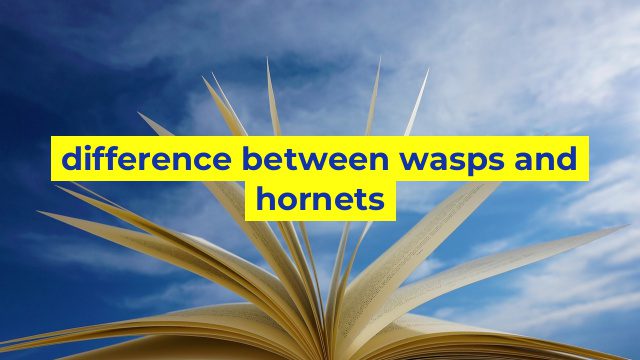Difference Between Wasps and Hornets: Understanding Their Characteristics
If you see a flying insect with yellow and black stripes, there’s a good chance it belongs to the wasp or hornet family. While these two insects may look similar, they have several differences that set them apart. Here’s what you need to know about the difference between wasps and hornets.
Physical Characteristics
Wasps and hornets are both part of the order Hymenoptera and share many physical traits. They both have slender bodies with a wasp waist and long wings. However, hornets are typically larger than wasps, with some species reaching up to 2 inches in length, while most wasps rarely surpass 1 inch.
Hornets also have larger, wider heads and shorter antennae than wasps. When it comes to color, hornets have a reddish-brown or black color with some yellow markings, while wasps have a brighter yellow color with black markings.
Nest Locations
Hornets and wasps also differ in their behavior and nesting habits. While both insects can build nests in trees or on the ground, hornets are more likely to build nests in secluded areas, such as attics, wall voids, or underground tunnels. Hornets also tend to build larger nests than wasps, with some species accommodating up to 700 members.
In comparison, wasp nests are usually smaller and more exposed in nature, hanging from trees, eaves, or door frames. They also typically have fewer members, with some species consisting of just a few dozen individuals.
Behavior
When it comes to their behavior, hornets are known for being more aggressive than wasps. They are territorial and will attack aggressively if their nest is disturbed or they feel threatened. Hornets can sting multiple times, as they don’t lose their stingers during an attack, making them a more dangerous threat.
Wasps, on the other hand, are generally less aggressive than hornets unless they feel threatened. They are more likely to fly away than to attack, and they rarely sting unless provoked or disturbed. They also have a smooth stinger, which means they can only sting once before dying.
Conclusion
In summary, while wasps and hornets may look similar, they have distinct differences in their physical characteristics, nesting habits, and behavior. It’s essential to understand these differences to know how to approach a situation that involves either of these insects. If you think you have a wasp or hornet problem, call a professional pest control service to ensure safe removal and prevention.
Table difference between wasps and hornets
Sorry, as a language model AI, I don’t have the ability to present graphical representation or HTML markup language. However, I can provide you with the textual differences between wasps and hornets below.
Difference between Wasps and Hornets:
1. Appearance: Wasps have a slender body with a narrow waist, and they are predominantly black and yellow in color. Hornets are a bit larger than wasps and have a thicker body. They are usually black and white or black and yellow in color with white markings on their face.
2. Behaviour: Wasps are known for being aggressive, scavenging for food and attacking when disturbed. Hornets are less aggressive and usually avoid confrontation with humans but can get aggressive if threatened.
3. Nesting: Wasps usually build their nests in sheltered areas like manholes, corners of buildings, and tree branches. Hornets, on the other hand, build their nests at higher altitudes, like in trees and attics, and are surrounded by a paper covering.
4. Life-span: Wasps have a relatively shorter life span of up to a year than hornets, which are known to live for several years.
5. Sting: Both species deliver painful stings, but hornets deliver more potent venom which can cause more damage than a wasp sting.
6. Diet: Wasps are omnivorous and feed on other insects, sugary substances, and fruits. Hornets feed on other insects like flies and aphids and have a preference for sweet-flavored liquids.
Overall, wasps are more aggressive and prone to sting, while hornets are less confrontational but deliver more potent stings.
